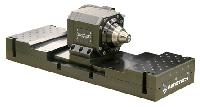Linear/Rotary Platform Combines Material Handling with Direct Drive, Rotary Motion

The system uses a pneumatically actuated type D collet closer with an aperture for product feed-through. The closer holds tubing with diameters from 0.1 mm to 7.9 mm in dry cutting applications and up to 3 mm for wet cutting applications. The closer is "designed to minimize axial tube motion during clamping operations by keeping the collet stationary and moving the tapered mating surface during collet open/close operation," says Byron Fruit, application engineer for Aerotech, Inc. "This minimization of tube motion eliminates the need for some operator intervention during processing, so as to provide a more automated and streamlined process."
The LaserTurn 1 has front and rear tooling platforms with M4 mounting features. They are bolted to the linear stage base to allow a stiff, common inertial frame of reference. This permits fixtures to be attached easily. The LaserTurn 1 is protected from fluids in wet cutting processing by a sloped, hard cover design.
Both the linear and rotary axes use a direct drive motor and encoder technology. Linear and rotary encoders are coupled directly to the load for high accuracy and repeatability.
The motion subsystem uses Aerotech's A3200 control system, which is completely digital and features FireWire networked drives. The digital construction optimizes current, velocity and position servo loops for performance. "The A3200 controller comes with a powerful software suite, which includes advanced diagnostic and tuning capabilities that allow the user to easily optimize the servo loop gains and view system response through a simple GUI," Fruit says.
The control system is capable of advanced trajectory generation capabilities like multi-block look-ahead, which reduces geometry errors that can occur in tight profiles by regulating cutting speed. The position-synchronized laser firing output feature adjusts laser pulse frequency to match the cutting speed, so optimal laser power coupling is maintained.
With the LaserTurn 1, "Aerotech's goal was to provide a motion subsystem tailored specifically to cardiovascular and neural stent manufacturing in order to provide the highest throughput and performance possible in a compact form factor," Fruit says. "This combination yields the lowest cost of ownership in the industry."





